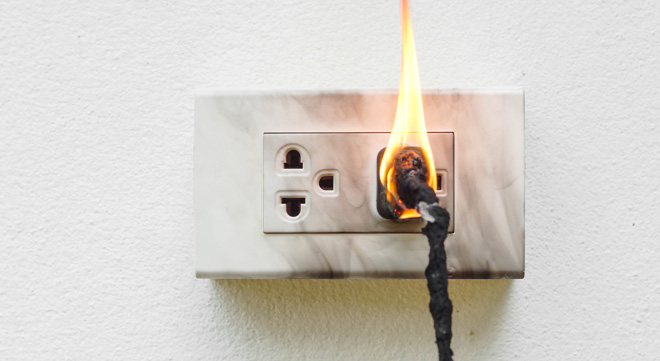There have been headlines in various media recently about insurers “pulling cover” for claims in the event of a failure of the national electricity grid. “Pulling cover” may give rise to the assumption that such cover existed in the first place. Is it not rather that insurers have introduced explicit provisions to make it clear that grid failure is not an insurable event?
Media interest in this issue seems to have been occasioned by the unprecedented levels of load shedding since the beginning of this year. However, insurers started to introduce grid-failure exclusions in 2022.
In March last year, Moonstone reported that Santam was phasing out business interruption (BI) covers that provide for “non-damage” (or “non-physical damage”) extensions for losses emanating from a grid failure. Our columnist, Paul Kruger, observed at the time: “No doubt, other insurers will be forced to follow suit.”
Later, in November last year, we reported that Santam had clarified that electricity grid failure was explicitly excluded from its personal and commercial lines policies, and it had introduced new commercial cover limits for BI: public telecommunications and public utilities (insured perils).
I had reason to revisit these articles after it was brought to Moonstone’s attention that this month Santam issued a communication to intermediaries about “fake information” circulating on social media about its insurance cover for load shedding. The communication referred to the exclusion and the commercial cover limits announced in November last year.
The general grid failure exclusion for personal lines states:
“We will not cover any loss, damage, legal liability, cost or expense of whatsoever nature directly or indirectly caused by, contributed to by, resulting from, arising out of, in connection with a national (including regional, municipal, local and/or private) interruption, failure or suspension of the electricity grid of South Africa for whatsoever reason, whether due to damage, an inability and/or failure, whether partial or total, of the utility supplier to generate, transmit or distribute electricity, or otherwise.”
As Attie Blaauw, Santam’s head of personal lines underwriting, explained, the insurer’s intention with the grid failure exclusion is to provide “absolute clarity” that should such an event happen, the unknown consequences of this and any damages related to such an event are not covered.
Where does this leave cover for power surges?
What particularly interested me was what the exclusion meant for cover for power surges. Note the wording of the exclusion: “[…] any loss, damage, legal liability, cost or expense of whatsoever nature directly or indirectly caused by, contributed to by, resulting from, arising out of […]”.
In September last year, Santam issued a media release stating, “Load shedding or blackouts are not an insurable risk under an insurance contract. However, insurers like Santam do offer cover for damage to sensitive electronic items that are caused by power surges.
“Power surges and dips happen as a result of loadshedding, leading to damage to electrical and electronic equipment in your home. When load-shedding stages increase, so does the frequency of the rotational power cuts, which has a replica impact in increased risk of damage to sensitive electronic items due to power surges […].”
This left me somewhat confused. Did this mean that cover for power surges was excluded if the power surge resulted from load shedding?
Blaauw provided the following response: “Power surge damage does not only happen because of load shedding. While power surge claims have increased significantly during load shedding, power surge damages also happen during periods without any load shedding. While these claims increase during load shedding, most of the damage occurs when electricity supply is restored, which is a separate event to the actual load shedding.
“Irrespective of when the damage happens during load shedding or when the power supply is restored, if the result is [a] power surge, clients will have cover. The same principle will apply should there be a failure of the national grid. [emphasis added]
“The intention of the grid failure exclusion is not to cancel power surge cover. The wording of the power surge cover will be clear that power surge damages will still be covered when the grid exclusion takes effect on existing clients, irrespective if this is directly or indirectly caused by a grid failure, load shedding, or otherwise.”
Blaauw also explained the difference between “basic covers” and “extended covers” in Santam’s policies.
Most of Santam’s personal lines contracts always stipulate the specific perils that are covered, such as theft, burglary and storm. These basic covers come standard with a specific contract.
Personal lines policies also offer additional covers, often referred to as extended covers. Power surges is one of these extended covers. Although some of extended covers also come standard with the product and provide limited cover, some are priced separately and can be removed or added depending on the client’s needs and cost consideration. In the case of cover for power surges, clients mostly must specifically select a cover limit if they require this cover, Blaauw said.
Spoiling of the contents of refrigerators and freezers
On the subject of extended covers, I also sought clarity from Santam on the amendment to its cover for the contents of refrigerators and freezers. The wording states:
We cover accidental spoiling of the contents of your refrigerators or freezers inside your private residence and outbuildings caused by a change in temperature.
Our compensation is limited to the amount shown in your policy summary. However, we do not cover the following:
(a) spoiling caused by someone adjusting the temperature control;
(b) damage to the refrigerators or freezers;
(c) spoiling due to load shedding, or electrical grid failure, of a power-supply authority on a national, regional, municipal, local and/or private level;
(d) spoiling as a result of non-payment or non-purchase of power or any type of fuel.
A claim under this cover will not affect your no-claim bonus.
Blaauw said that for most of Santam’s mainstream policies, R5 000 spoiling of contents cover is provided as standard, with clients having the option to increase the limit.
Currently, cover is specifically excluded when the duration of load shedding is less than 24 hours, and grid failure is not excluded.
“The revised exclusions mean there is no cover for both a grid failure and prolonged periods of load shedding. This is the only material impact on the cover we provide currently,” Blaauw said.
Material conditions obligation
Advisers are obliged to disclose and explain material conditions of policy contracts to their clients. This normally occurs during annual renewals, but in abnormal instances such as those we are currently experiencing, it is incumbent upon advisers to explain and clarify conditions such as “grid failure” to clients. Too often, “failure to disclose material conditions” has led to the various ombuds finding against the adviser, despite the insurer having written to the client to explain this.
Read: What insurers’ grid failure exclusions mean for clients





I Fully understand the reasoning behind this new wording , however it is complexed, and clients do not like when cover is removed .I am also sure the other companies will follow suite with this . As power surge is not in anyone’s control we will have to explain it to clients in plane language , perhaps a small reduction in premium would be appropriate but unlikely . Lets hope things return to normal soon?
santam Does not even pay for hail damage. grabbing the excuse of wear and tear on old buildings. QUICK TO TAKE YOUR MONEY THEN DONT PAY OR OFFER.MINIMUM HELP. THIS WITH MOST INSURERS PAY THE RICH AT THE EXPENSE.OF THE POOR
I also didn’t know that power surge is not covered fully by Santam. It was my first time hearing about it when claiming. That made me realize that insurances are not really here to help us ,they are sometimes here to frustrate us. We are not always aware that there will be no electricity so we will lose and the reason to take home contents insurance is to be safe should accident like these happens.
Hi Nomfundo,
While I agree with you it can be very frustrating, one thing I think people should keep in mind is that insurance is not a charity. Imagine if the entire country goes dark for a month, just think of the amount of claims that will be paid. Not a single insurer will survive that, which will then leave everyone uninsured for the major events such as a vehicle accident or robbery.
[…] The official Communication from Santam See Moonstone’s Article on what this means […]
“We will not cover any loss, damage, legal liability, cost or expense of whatsoever nature directly or indirectly caused by, contributed to by, resulting from, arising out of, in connection with a national (including regional, municipal, local and/or private) interruption, failure or suspension of the electricity grid of South Africa…”.
This original statement explicitly excludes ANY damage due to loadshedding (which is an ” interruption, failure or suspension of the electricity grid …”). It was corrected, not clarified, by further statements. It is true that voltage irregularities (dips, surges, spikes) can occur during normal grid operation, but the frequency and intensity of these occurrences are hugely magnified when the grid (or parts thereof) is turned on and off.
It’s noticeable that damage to fridges & freezers aren’t covered; compressors don’t like unstable voltage supply, although I don’t know generally how long it takes the grid voltage to stabilise after supply resumption. And high overvoltages can damage the electronics.
The optimal solution is to get class 2 whole-house surge protection installed in your db, and then class2/class3 plug-in surge-protectors (they don’t have to be the high-surge ones) for the really important and sensitive stuff. Get one with a delay for each fridge and freezer. If you don’t get the whole-house protectors then get the high-surge plug-in surge protectors for your equipment that you don’t turn off. I do this, with the addition of a delay unit for the fridge.
I’m not concerned about class1 surge protection as I don’t live in a lightning-prone area.